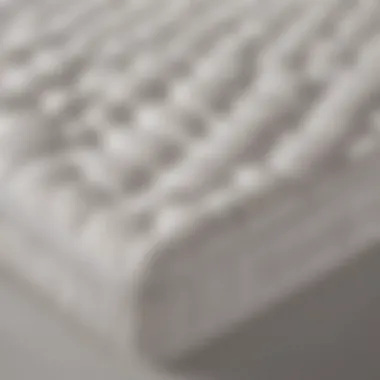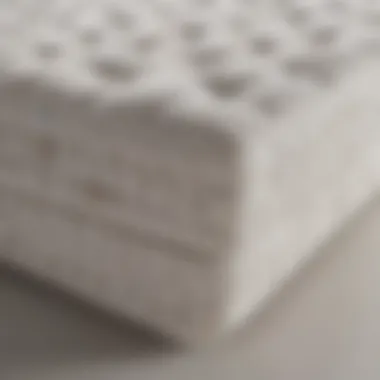Exploring the Great Firm Mattress: Benefits and Options


Intro
A great firm mattress is more than just a sleeping surface; it is a cornerstone of restful sleep and overall well-being. For many individuals, the choice of a mattress significantly influenced by personal comfort and health needs. This article aims to unpack the many dimensions of selecting the right firm mattress, from understanding spine health benefits to exploring various material options. Whether you are a homeowner rethinking your bedroom’s design or someone seeking the best sleep solution, there is a wealth of information to consider.
Firm mattresses play a crucial role in providing adequate support for the spine, which can lead to better posture and reduced back pain. It is essential to delve into the common misconceptions surrounding mattress firmness. While some believe that a soft mattress is all you need for comfort, evidence suggests that a firmer option might be ideal for maintaining spinal alignment.
The mattress market offers a variety of choices that cater to different preferences. Each material, from memory foam to latex, brings its own set of advantages and potential drawbacks. This overview will guide you through these options, ensuring you make an informed decision based on your specific needs.
In addition, this guide will not only focus on functionality but will also consider aesthetic aspects of a firm mattress in a bedroom setting. A well-chosen mattress can enhance the overall design and comfort of a space, making it both practical and visually appealing. The journey of selecting the right firm mattress begins with understanding its core benefits.
Understanding the Firm Mattress
A firm mattress is often viewed as a crucial component for achieving quality sleep. Understanding its characteristics is essential, especially when considering a purchase. A firm mattress is designed to provide ample support, keeping your spine in its natural alignment during sleep. This alignment is vital for overall health and well-being.
Defining what constitutes firmness, however, can be somewhat subjective. It varies significantly from person to person based on individual needs and preferences. Identifying a suitable firmness level involves evaluating specific elements such as body weight, sleeping position, and personal comfort. Each of these factors plays a role in determining the right choice for any sleeper, whether they like it harder or softer under their body.
When selecting a mattress, support is often regarded as the primary function, particularly for those who experience back issues or prefer sleeping on their back or stomach. A well-constructed firm mattress can alleviate pressure points, allowing for proper posture. This support prevents misalignment and, in turn, can reduce discomfort.
Overall, understanding the composition and benefits of a firm mattress serves as a foundation for making an informed decision. It lays the groundwork for exploring broader topics related to materials, benefits, and practical considerations when choosing a mattress suitable for one's needs.
Defining Firmness
Firmness levels are not universally standardized. Different brands may define firmness differently, leading to potential confusion during the selection process. Typically, firmness is categorized on a scale from soft to hard. A firm mattress may rate around six to eight on a scale of ten.
Factors that contribute to perceived firmness include:
- Material composition: Different materials can affect how firmness is felt. For instance, memory foam will generally feel softer than innerspring systems of similar firmness rating.
- Body weight: Heavier individuals may press deeper into a mattress, making it feel softer than it actually is. Lighter individuals may find a mattress feels firmer because they do not sink in as much.
- Design features: Mattresses with a pillow top may soften the surface feel even if the underlying layers are firm.
Understanding firmness isn't merely a matter of comfort; it also connects to health and well-being, specifically in relation to spinal support.
Importance of Support
Support in a mattress is a fundamental attribute that affects sleep quality and overall health. A firm mattress typically offers enhanced support that is crucial for several reasons.
- Spinal Alignment: A well-supported spine can maintain its natural curve throughout the night. This is especially important for those who sleep on their backs or stomachs. A firm mattress helps to ensure the spine remains aligned rather than sagging, which can cause discomfort and lead to pain over time.
- Pressure Distribution: A firm mattress also actively distributes body weight. This can reduce pressure points that might develop due to sleeping in a single position over long periods. An even distribution leads to a more restful sleep experience, minimizing wakefulness caused by discomfort.
- Body Movement: For couples, a firm mattress often minimizes movement transfer. This means that if one partner shifts positions during the night, the other may be less likely to wake up.
In summary, the importance of support cannot be overstated. It forms the groundwork of what makes a mattress an essential element in sleep hygiene and comfort.
Benefits of a Firm Mattress
A firm mattress is often recommended by supporters for its array of advantages related to support and comfort. This variety of mattress meets various health and lifestyle needs, making it crucial to understand its benefits. Each advantage correlates with essential aspects of sleep health and general well-being. Here, we will discuss how a firm mattress can improve spinal alignment, reduce back pain, and provide durability over time.
Enhanced Spinal Alignment
Proper spinal alignment is critical for maintaining good posture and overall health. A firm mattress can help achieve this alignment, as it keeps the body elevated and properly aligned during sleep. When the spine is straight, it means that the cervical, thoracic, and lumbar areas have adequate support. This is particularly beneficial for those who suffer from conditions like scoliosis or other spinal deformities.
A study found that when sleepers use a firm mattress, it decreases pressure on specific points like the hips and shoulders. A reduction in pressure helps prevent conditions such as herniated discs. One can also use additional considerations, such as incorporating adjustable bed frames which allow for further tailoring the sleeping experience.
Reduced Back Pain
Back pain is a common complaint in many adults. Firm mattresses can play a significant role in alleviating this discomfort. They provide support that avoids excessive sinking. While plush mattresses may feel comfortable initially, they can lead to misalignment and increased pain over time. A firm mattress actively resists sagging, maintaining even support across the body.
For individuals with existing back pain, switching to a firmer option might offer immediate improvements in sleep quality. Recommendations often include a firmness level that is tailored to personal comfort preferences. However, people with specific conditions should seek medical advice before making any changes.
Durability and Longevity


When investing in a mattress, its lifespan is a significant consideration. Firm mattresses generally last longer than softer alternatives. They are built to withstand more weight and pressure without significant wear. This durability means that individuals often find themselves needing to replace their firm mattresses less frequently.
Firm mattresses, particularly those made from high-quality materials such as latex or high-density foam, show great longevity in their performance. This aspect represents not only an economic advantage but also contributes to consistent sleep performance. In this regard, selecting a firm mattress can be seen as a value investment.
"A firm mattress is an investment in your sleep health. Proper support leads to better restorative rest."
Material Options for Firm Mattresses
Choosing the right material for a firm mattress significantly impacts the comfort and support it provides. Each type of mattress material brings unique qualities, affecting factors like sleep temperature, spinal alignment, and general durability. Understanding these options allows consumers to select a mattress that meets their personal needs. This section will discuss four primary material types: innerspring, memory foam, latex, and hybrids. Each has varying degrees of firmness and support characteristics that may cater to different preferences and requirements.
Innerspring Mattresses
Innerspring mattresses are one of the most traditional mattress types. They utilize a system of coils for support, which offers a bouncy feel. The firmness can vary based on the number and gauge of coils, as well as the arrangement.
- Support: The coils provide strong support, which is essential for proper spinal alignment.
- Breathability: These mattresses tend to have good airflow due to the space between coils, helping with temperature regulation during sleep.
- Cost-Efficiency: Generally, innerspring options can be more budget-friendly compared to other materials.
However, it is worth noting that the comfort layer on top can make a significant difference. Softer top layers can increase comfort, while a firmer design may amplify support.
Memory Foam Mattresses
Memory foam mattresses are notable for their ability to contour to the body’s shape. They offer excellent support and pressure relief, making them a solid choice for many sleepers.
- Pressure Relief: The material naturally conforms to the body, reducing pressure points, which can alleviate discomfort.
- Motion Isolation: Excellent for couples as movements are less likely to disturb the other partner’s sleep.
- Firmer Options Available: Many brands offer variations with greater firmness, catering to those looking for firm support without sacrificing comfort.
Despite these benefits, some may find memory foam retains heat. Choosing a mattress with cooling technologies can mitigate this downside.
Latex Mattresses
Latex mattresses, made from natural or synthetic latex, offer a unique balance of support and comfort. They are known for their resilience and durability.
- Natural Materials: Natural latex is a more eco-friendly option, appealing to environmentally conscious buyers.
- Durability: These mattresses tend to be long-lasting, often exceeding the lifespan of other types.
- Support and Bounce: Offer a firmer feel but also retain a degree of bounciness, providing both support and comfort.
In addition, latex mattresses typically maintain a cooler sleeping surface, which is a plus for those who sleep hot. Thus, latex can be a good match for firmer support with a pleasant sleeping experience.
Hybrid Mattresses
Hybrid mattresses combine the support of innerspring systems with the comfort of foam or latex. This design aims to offer the best of both worlds.
- Balanced Comfort and Support: The innerspring coils provide support, while the foam layer offers cushioning.
- Versatility: Many hybrid models cater to different sleeper types, offering options that range from soft to very firm.
- Temperature Control: Hybrids typically have good airflow, reducing heat retention compared to all-foam mattresses.
When selecting a hybrid, it’s essential to test the firmness and ensure both support layers work harmoniously to meet the individual’s sleep style.
"Understanding the material options available is crucial when selecting the right firm mattress for optimal sleep health."
Ultimately, the decision for a firm mattress heavily relies on personal preferences, budget, and specific sleep needs. Careful consideration of the different materials will lead to a more informed choice.
Considerations When Choosing a Firm Mattress
When selecting a firm mattress, several critical factors come into play. These factors influence the overall sleeping experience and ensure that the mattress meets individual needs. Understanding these considerations can help shoppers make informed choices based on their preferences and requirements.
Sleep Position and Preference
People sleep in various positions: on their back, side, or stomach. Each position demands different support levels from a mattress. For instance, side sleepers often benefit from a slightly softer surface that cushions the shoulders and hips. Conversely, back and stomach sleepers generally require firmer support to maintain spinal alignment. The firmness of a mattress significantly impacts comfort and overall sleep quality. Shoppers should pay attention to their own sleeping habits when choosing a firm mattress.
It is also advisable to test the mattress in the store. Laying on the mattress for several minutes can reveal whether it aligns well with your preferred sleeping position. If you are not able to test in-store, look for brands offering trial periods to assess comfort at home.
Body Weight and Firmness Level


Body weight plays a crucial role in determining the appropriate firmness level. Lighter individuals often find firm mattresses uncomfortable, as they may not sink in enough to feel supported. Conversely, heavier individuals typically require a firmer mattress to avoid sagging and ensure support.
For those within the average weight range, a medium-firm option might provide a balanced experience. It is worth noting that there is no one-size-fits-all solution. Size and shape will vary from person to person, impacting how a mattress feels. Therefore, assessing personal weight and preferences is essential when making a selection.
Temperature Regulation
Temperature regulation is another important factor in mattress selection. A firm mattress can trap heat, causing discomfort during sleep. Materials like memory foam, while supportive, often retain warmth. In contrast, latex mattresses provide better temperature regulation because of their bouncy, breathable structure.
Look for features like gel-infused layers or breathable cover fabrics. These elements can improve airflow and mitigate heat retention. Shoppers should consider their climate and personal heat preferences before making a choice.
A well-chosen firm mattress can provide needed support while promoting a comfortable sleep temperature.
Common Misconceptions About Firm Mattresses
Firm mattresses often carry a stigma, leading many potential buyers to harbor misconceptions that can hinder effective purchasing decisions. This section aims to clarify these misconceptions, providing insights that can assist homeowners and interior design enthusiasts in selecting the right product for their needs.
Firm Does Not Mean Uncomfortable
One of the most prevalent misconceptions is that a firm mattress inherently leads to discomfort. Many believe that firmness equates to a rigid and unforgiving surface. However, this assumption overlooks the complexity of mattress designs. A firm mattress is specifically designed to support the body, maintaining proper spinal alignment. This support ultimately enhances comfort by distributing body weight more evenly.
A quality firm mattress often incorporates advanced materials that provide a blend of support and softness. For instance, high-density foam or innerspring systems can deliver firm support while still contouring to the body's curves. It is essential to consider the overall construction rather than solely focusing on the firmness rating.
"A firm mattress can promote better sleep quality by offering the necessary support without sacrificing comfort."
This makes it crucial for individuals to test out firmness levels, as personal preference varies widely. People who sleep on their back or stomach generally benefit from a firmer surface, while side sleepers may prefer a more plush option. Understanding that firmness does not inherently equal discomfort is vital in exploring the best options.
The Role of Mattress Toppers
Another common misconception is that firm mattresses are not adaptable to personal comfort preferences. Many individuals are unaware of the role that mattress toppers can play in modifying mattress feel. A topper can effectively alter the surface, providing additional cushioning without changing the fundamental support structure of the mattress itself.
There are various materials available for toppers, including memory foam, latex, and feather options. Each type offers unique benefits. For example:
- Memory Foam: Conforms to the body, reducing pressure points.
- Latex: Offers a balance of support and comfort, maintaining breathability.
- Feather: Provides a plush feel, suitable for those who want some softness on a firm base.
By investing in a quality topper, sleepers can customize their firm mattress to achieve the desired level of comfort, combating potential discomfort. This flexibility allows for a tailored experience based on varying personal needs and preferences, making it easier than ever to enjoy the advantages of a firm mattress.
Understanding these misconceptions can empower consumers to make informed choices about firm mattresses. Buyers should focus on individual needs, rather than relying solely on general perceptions, to find a solution that enhances their overall sleep experience.
Maintaining Your Firm Mattress
Maintaining your firm mattress is essential for ensuring both longevity and optimal performance. A well-maintained mattress can provide years of support and comfort. Regular maintenance prevents many common issues such as sagging or the buildup of allergens. Here are some specific elements to consider:
- Cost-Effectiveness: A good firm mattress represents a significant investment. Proper maintenance can protect this investment and extend its lifespan, helping you avoid premature replacement.
- Health Benefits: Regular upkeep helps in maintaining hygiene. Dust mites, bacteria, and allergens can accumulate over time. Cleaning reduces these health risks, promoting a better sleep environment.
- Performance: A mattress that is regularly cared for maintains its support and comfort levels. This means better spinal alignment and support through the years.
By focusing on these specific aspects, you can enjoy the benefits of a firm mattress for a longer period.
Regular Cleaning Practices
Cleaning your firm mattress is crucial to keeping it fresh and free from allergens. Here are some basic practices to follow:
- Vacuuming: Use an upholstery attachment to vacuum the surface of the mattress. This removes dust, hair, and debris. Aim to do this every few months.
- Spot Cleaning: For stains, use a mild detergent mixed with water. Dab the area gently with a cloth. Avoid soaking the mattress as it can lead to mold growth.
- Deodorizing: Sprinkle baking soda over the mattress surface. Let it sit for a few hours before vacuuming it off. This absorbs odors and moisture.
- Air Out: If possible, allow your mattress to air out in a well-ventilated area. This helps to eliminate trapped odors and moisture.
Flipping and Rotating Techniques
Regularly flipping or rotating your mattress is another essential maintenance practice. This helps in distributing wear evenly, preventing sagging in specific areas.


- Rotation: Many manufacturers recommend rotating your mattress every three months. This means turning it 180 degrees so the head becomes the foot.
- Flipping: If your mattress is double-sided, it should be flipped over every six months. This balances wear and helps prolong its life.
- Signs of Wear: Look for signs such as visible indentations. If you notice sagging or discomfort, it’s time to rotate or flip your mattress.
Regular maintenance protects your mattress investment, enhances comfort, and promotes better sleep.
By integrating these practices into your routine, you can maintain a firm mattress that offers consistent support and comfort throughout its lifespan.
Integrating a Firm Mattress into Your Design
Integrating a firm mattress into your interior design involves understanding how it interacts with the overall aesthetics and functionality of a bedroom. This topic is significant as a mattress is not only a functional item but also a focal point in the room. Selecting the right elements enhances the visual appeal while ensuring comfort and support.
Choosing the Right Bed Frame
The bed frame serves as the foundation for your mattress. A well-chosen frame can elevate the appearance of a firm mattress, contributing to a cohesive design. When selecting a bed frame, consider the following factors:
- Material: Wooden frames give a classic touch while metal frames can provide a modern feel. Each material has its own aesthetic.
- Height: The height of the frame can influence accessibility. Lower frames may suit a minimalist design, whereas higher frames can add grandeur.
- Style: Consider whether you prefer a platform bed, sleigh bed, or upholstered frame. The style should harmonize with the rest of your interior décor.
Find a frame that complements the firmness of your mattress, making it appear as an integrated part of the room rather than an afterthought.
Bedding Selection
Bedding selection plays a crucial role in the overall design scheme. Choosing the right bedding for a firm mattress involves considering both aesthetics and practicality. Here are some recommendations for effective bedding selection:
- Material: Opt for breathable fabrics like cotton or linen. This helps maintain temperature regulation while also being visually appealing.
- Color Palette: Select colors that match or contrast harmoniously with the room's color scheme. Soft tones may promote relaxation, while vibrant colors can energize a space.
- Layering: Use layers that add texture and dimension. A light comforter with decorative pillows can enhance the mattress without overwhelming the visual space.
By carefully choosing bedding, you can create an inviting and cohesive look that balances the looks of your firm mattress with the rest of your interior design.
"The right combination of firm mattress and stylish design can transform a bedroom into a sanctuary of comfort and elegance."
Top Recommendations for Firm Mattresses
Choosing a firm mattress can have a significant impact on sleep quality, body alignment, and overall health. The right firm mattress not only offers the necessary support but also conforms to individual preferences, providing the ideal sleeping environment. Given the wide variety of options available in the market today, it is crucial to understand which mattresses stand out among the rest. This section will cover some essential recommendations, helping readers navigate their choices with clarity.
Top Industry Picks
When it comes to selecting the best mattresses in the industry, several products frequently receive praise for their performance and durability. Notable mentions include:
- Saatva Classic: This innerspring mattress combines luxury and support. Its eco-friendly materials and various firmness options cater to different sleeper preferences, making it a popular choice.
- Helix Midnight: Customized to suit a range of sleeping positions, the Helix Midnight seamlessly balances comfort and support. It provides excellent spinal alignment, which is necessary for restful sleep.
- Purple Hybrid: Utilizing a proprietary hyper-elastic polymer grid, the Purple Hybrid offers a unique feel. It combines responsiveness with pressure relief, targeting those who experience discomfort on traditional mattresses.
These selections represent brands recognized for their innovation and commitment to quality in the mattress industry.
Consumer Favorites
Consumer reviews and preferences often guide potential buyers toward certain mattresses that exhibit exceptional qualities. Here are some consumer-favorite options:
- Tempur-Pedic TEMPUR Adapt: Renowned for its adaptive memory foam, this mattress molds to the body while maintaining firm support. It is favored by customers looking for a solution to relieve back pain.
- Amerisleep AS2: This medium-firm mattress uses eco-friendly materials and provides solid spinal support. It's a choice often recommended for back and stomach sleepers.
- Bear Mattress: Targeting active individuals, the Bear Mattress is designed with recovery in mind. It delivers firmness while aiding in muscle recovery during sleep.
These mattresses have garnered substantial appreciation from consumers for their performance and value, making them worthy of consideration in your search for the right firm mattress.
"A mattress should support the body in a way that promotes alignment, allowing for uninterrupted sleep and rejuvenation."
Each of these recommendations showcases different aspects of firmness, adaptability, and responsiveness, catering to the diverse needs of potential buyers.
Closure on the Great Firm Mattress
In concluding our discussion about the firm mattress, it is crucial to appreciate its significance. A firm mattress is not merely a choice; it is a pivotal element in achieving quality sleep and maintaining overall health. The structural design offers essential support, aiding in the alignment of the spine. By using a firm mattress, individuals may experience alleviation from back pain and improved sleep quality.
Choosing a mattress involves more than just comfort preference. It is imperative to consider body weight, sleeping position, and personal comfort needs. A well-selected firm mattress can cater to various sleeping styles, supporting the body adequately during rest. Furthermore, durability is a notable attribute; firm mattresses often last longer than their softer counterparts, thus making them a wise investment in the long run.
"The right mattress is one of the most important decisions for your health."
In terms of design, integrating a firm mattress into your bedroom setup adds an element of sophistication while ensuring functionality. Selecting the right bed frame and complementary bedding can enhance the overall aesthetic, creating a tranquil sleeping environment.
Ultimately, the choice of a firm mattress goes beyond mere comfort preferences. It embodies a commitment to health, support, and longevity in sleep. Gaining a comprehensive understanding of these elements enables buyers to make informed decisions that align with their unique needs and values. In this vein, exploring various options and recommendations becomes essential for discerning consumers who prioritize their well-being.















